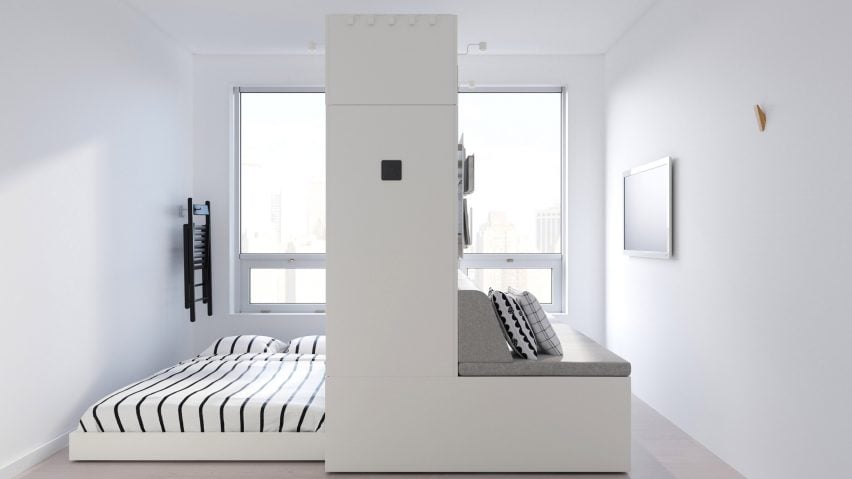IKEA has partnered with American startup Ori on Rognan, a shape-shifting furniture system that moves robotically to create more flexible living areas in compact homes.
Unveiled this week at Democratic Design Days, IKEA's annual conference, the system is a combination of Ori's robotic platform and IKEA's existing Platsa storage solution.
By touching a button, the system retracts on wheels to provide a further eight square metres of living space that can transform a living room into a bedroom or walk-in closet.
One side might contain a tucked-in bed, while the other could offer storage and a seating area, or any other space-saving combination.
"Instead of making the furniture smaller, we transform the furniture to the function that you need at that time," explained product developer for new innovations at IKEA, Seana Strawn.
"When you sleep, you do not need your sofa. When you use your wardrobe, you do not need your bed etc."
The system works through a combination of mechanics, electronics and software that combine to create a moving bank of furniture. Some of the technology used is already found in lawnmowers, robotic vacuum cleaners and other household goods.
The robotic element involves the system creating a map of the space using machine learning the first few times it moves across the floor. This allows the system to build up a picture of the room.
"Every floor is different, so you need a product that's smart enough to know this, and make a map of the floor," said founder and CEO of Ori, Hasier Larrea.
The system then compares this map to other forces against it, such as a person sitting in its path, or an item of furniture.
Larrea compares the product to the chassis of a car, on which you build different exteriors depending on the user's needs and aesthetic requirements, allowing people to "live large in a small footprint".
He believes that people's mindset and behaviour will need to adapt to living in smaller spaces in the future, and Rognan can be one tool to achieve this.
Rognan is intended for those living in small spaces in urban environments. With 1.5 million people joining the global urban population each year, and cities becoming increasingly cramped, people are turning to solutions that fit the shrinking size of their homes.
"We have been working with developing small space living solutions for a long time, and we know that some of the biggest challenges in peoples' homes are storage and finding the place to do all the activities that you'd want to do in your home," said Strawn.
"This is especially the case in big cities where people have to make compromises in the functions of their homes. We wanted to change that."
"We cannot keep designing spaces the same way we've been designing spaces 20 years ago, or keep using all the same furniture we were using in homes that were twice the size, or three times the size," added Larrea.
"We need to start thinking about furniture that adapts to us, and not the other way around."
Ori first introduced a commercial robotic interior product two years ago, working with MIT's Media Lab and designer Yves Béhar. They partnered with IKEA at around the same time to work on a version of the product that could be sold in IKEA stores.
The result, Rognan, will be trialled in the Hong Kong and Japanese markets from early next year, with a view to expanding into other regions with a product tailored to the particular living conditions of the area.
For example in the US, the product could be adapted for a bed larger than the 120-centimetre version common in the east Asian market.
Ori has previously worked on the Pocket Closet, which is an expandable walk-in wardrobe, an iteration of the MIT project called Studio Suite. It is currently also working on Cloud Bed, which drops from above when the owner wants to go to sleep.
Other innovations unveiled at Democratic Design Days include a homeware collection produced from rice straw and a vision for subscription-based housing.

